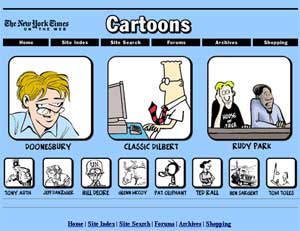CRITIQUE ARCHIVE
http://www.nytimes.com/diversions/cartoons
Comics, Cartoons, and Funnies: Good Morning, America
By Christa Starr
In the early 1990's, comic book sales in America were at an all-time high. Scott McCloud's book Understanding Comics helped to characterize the art form of comics, defining to it as "juxtaposed pictorial and other images in deliberate sequence." At that time, most comics writers and readers were focusing their attentions on the book, the graphic novel, the long-form story-centered manifestation of sequential art. However, many Americans had their first introduction to comics in a very different form. They were not featured in books. They took up a very small space in the local newspaper. They were, and sometimes still are, called "the funnies."The Funnies. Juxtaposed pictorial (usually line drawings) and other images (the
occasional clip art) in deliberate sequence (typically three or four panels). And, for some reason, very rarely funny. But I read them every morning. Years before I became addicted to Neil Gaiman's Sandman or collected Ennis and Dillon's Preacher, I would sit down at

breakfast, steal the single funnies page from Dad's Entertainment section, and try to figure out just what was so amusing about Cathy's latest swimsuit crisis or The Family Circus's trip to Grandma's.
And now, for all of us who never bothered with the rest of the morning paper, the New York Times has set up a web site for the funnies. At www.nytimes.com/diversions/cartoons, you can spare yourself the twenty-five cents and get what you really want - those short morning strips, often obscure, sometimes amusing, and the perfect diversion to go with your bagel and coffee.
The New York Times showcases three major comic strips: Doonesbury, Dilbert, and Rudy Park. They also include several other comics, which I have to say I've never even heard of. Though I miss the old classics like Garfield and I wonder about the lack of Zippy the Pinhead in the lineup, the available funnies are quirky and original - enough to keep me interested, at least. The site also has a nice backlog of strips available, about three weeks' worth. So, if you can't quite figure out what the latest fight between Dilbert and his manager is about, just go back a few days to the beginning of the thread.
This site is certainly not the vanguard of the online comics movement (for more information about that, see www.scottmccloud.com). It merely repackages traditional newspaper funnies and posts them online. Which is not a bad thing - especially when it keeps those inky newspaper fingerprints off my coffee mug.